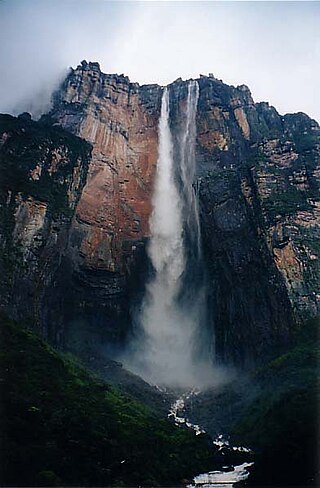
Venezuela is a country in South America, bordering the Caribbean Sea and the North Atlantic Ocean, between Colombia and Guyana. It is situated on major sea and air routes linking North and South America. Located at the northernmost end of South America, Venezuela has a total area of 912,050 km2 (352,140 sq mi) and a land area of 882,050 km2 (340,560 sq mi). It is the 32nd largest country and is slightly smaller than Egypt, or half the size of Mexico. Shaped roughly like an inverted triangle, the country has a 2,800 km (1,700 mi) long coastline. It is bound on the north by the Caribbean Sea and the Atlantic Ocean, on the east by Guyana, on the south by Brazil, and on the west by Colombia. It has the 55th largest Exclusive Economic Zone of 471,507 km2 (182,050 sq mi). Its maritime territory borders Trinidad and Tobago, Dominica, the Dominican Republic, Grenada, St. Kitts and Nevis, St. Vincent and the Grenadines, France, the United Kingdom, the Netherlands, and the United States. The Guyana–Venezuela territorial dispute has continued since the nineteenth century, with Venezuelan claiming a territory it calls "Guayana Esequiba", which is currently controlled by Guyana.

Tugela Falls is a complex of seasonal waterfalls located in the Drakensberg of Royal Natal National Park in KwaZulu-Natal Province, Republic of South Africa. According to some measurements, it is the world's tallest waterfall. A revisited validation of waterfall measurements is not available, and there's still uncertainty whether Tugela or Venezuela's Angel Falls is the tallest.

Angel Falls is a waterfall in Venezuela.

A tepui, or tepuy, is a table-top mountain or mesa found in South America, especially in Venezuela and western Guyana. The word tepui means "house of the gods" in the native tongue of the Pemon, the indigenous people who inhabit the Gran Sabana.

Auyán-tepui, also spelt Ayan, is a tepui in Bolívar state, Venezuela. It is the most visited and one of the largest tepuis in the Guiana Highlands, with a summit area of 666.9 km2 (257.5 sq mi) and an estimated slope area of 715 km2 (276 sq mi).

Bolívar is one of the 23 states of Venezuela. The state capital city is Ciudad Bolívar and the largest city is Ciudad Guayana. Bolívar State covers a total surface area of 242,801 km2 (93,746 sq mi) and as of the 2011 census, had a population of 1,410,964. The state contains Angel Falls.

Mount Roraima is the highest of the Pacaraima chain of tepuis or plateaux in South America. It is located at the junction of Brazil, Guyana and Venezuela. A characteristic large flat-topped mountain surrounded by cliffs 400–1,000 m (1,300–3,300 ft) high. The highest point of Mount Roraima is located on the southern edge of the cliff at an altitude of 2,810 m (9,220 ft) in Venezuela, and another protrusion at an altitude of 2,772 m (9,094 ft) at the junction of the three countries in the north of the plateau is the highest point in Guyana. The name Mount Roraima came from the native Pemon people. Roroi in the Pemon language means "blue-green", and ma means "great".

The Pemon or Pemón (Pemong) are indigenous people living in areas of Venezuela, Brazil, and Guyana. The Pemon people are divided into many dialects and traditions, which are Arekuna, Kamarakoto, and Taurepang.

Canaima National Park is a 30,000 km2 (12,000 sq mi) park in south-eastern Venezuela that roughly occupies the same area as the Gran Sabana region. It is located in Bolívar State, reaching the borders with Brazil and Guyana. The park was named a World Heritage Site by UNESCO.

The Caroní River is the second most important river of Venezuela, the second in flow, and one of the longest, 952 kilometres (592 mi) from the Kukenan tepui through to its confluence with the Orinoco River. The name "Caroní" is applied starting from the confluence of the Kukenan with the Yuruaní River at 182 kilometres (113 mi) from the source of the Kukenan and 770 kilometres (480 mi) from its discharge in the Orinoco. The confluence takes place in Bolivar State. The Caroní River is the longest river located entirely within Venezuela.

James "Jimmie" Crawford Angel was an American aviator after whom Angel Falls in Venezuela, the tallest waterfall in the world, is named.
La Gran Sabana is a region in southeastern Venezuela, part of the Guianan savanna ecoregion.

The Guayana Region is an administrative region of eastern Venezuela.

Venezuelan Air Force's Museo Aeronáutico de Maracay is a historical aviation museum of military and civic aeronautic technology inaugurated on 10 December 1963 and located at the installations of the former Aeropuerto Nacional Florencio Gómez adjacent to the Venezuelan Air Force officer graduation school, and the "Cradle of Venezuelan Military Aviation" in the City of Maracay, Estado Aragua, Venezuela.

Aleksandr Aleksejevich Muzychenko is a retired Soviet/Russian sailor, Olympic champion for the USSR team.

Ruth Agnes McCall Robertson Marietta was an American photojournalist who accomplished many "firsts" for women photographers and is also known mostly for photographing Angel Falls in Venezuela and surveying them to establish them as tallest waterfalls in the world; it was published in National Geographic magazine, November 1949. She was born in Taylorville, Illinois.

Tourism in Venezuela has been developed considerably for decades, particularly because of its geographical position, the variety of landscapes, the richness of plants and wildlife, the artistic expressions and the privileged tropical climate of the country, which affords each region throughout the year. Since 2013, the country is having a very severe economic and political crisis affecting tourism all over the country.

Fèlix Cardona i Puig was a Spanish explorer of the Venezuelan Guyana.

Juan María Mundó Freixas was a Spanish explorer and diamond trader.

The Guayana natural region, also simply known as Guayana in Venezuela, is a large massif of approximately 441,726 km2 (170,551 sq mi) area, equivalent to 48.2% of the total continental territory of the country.



















